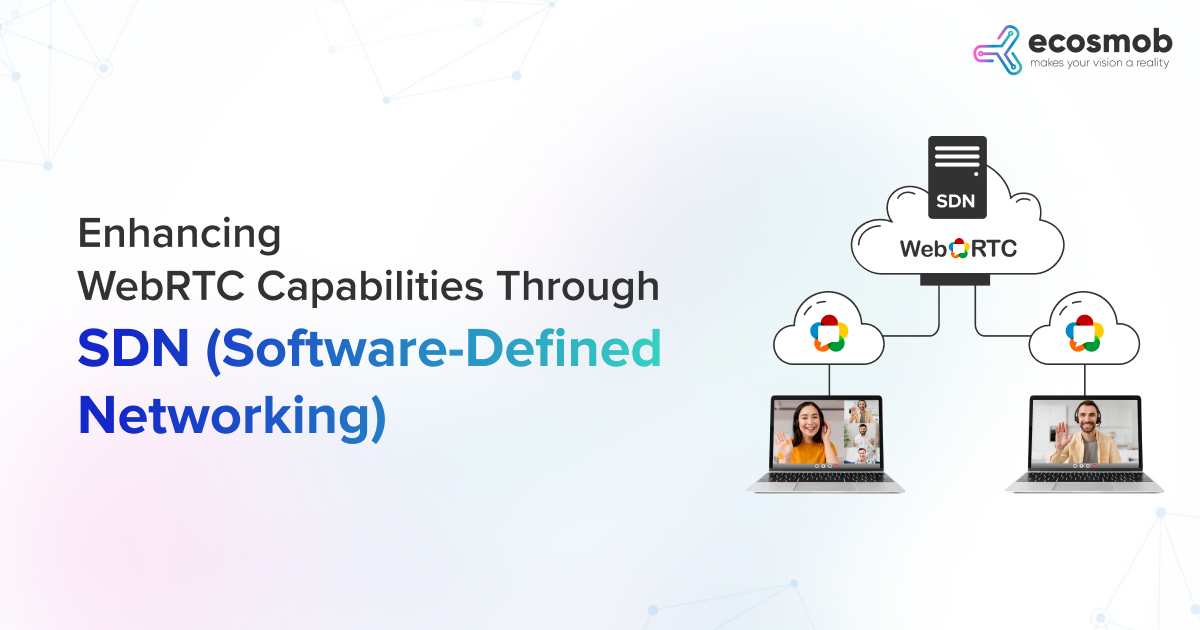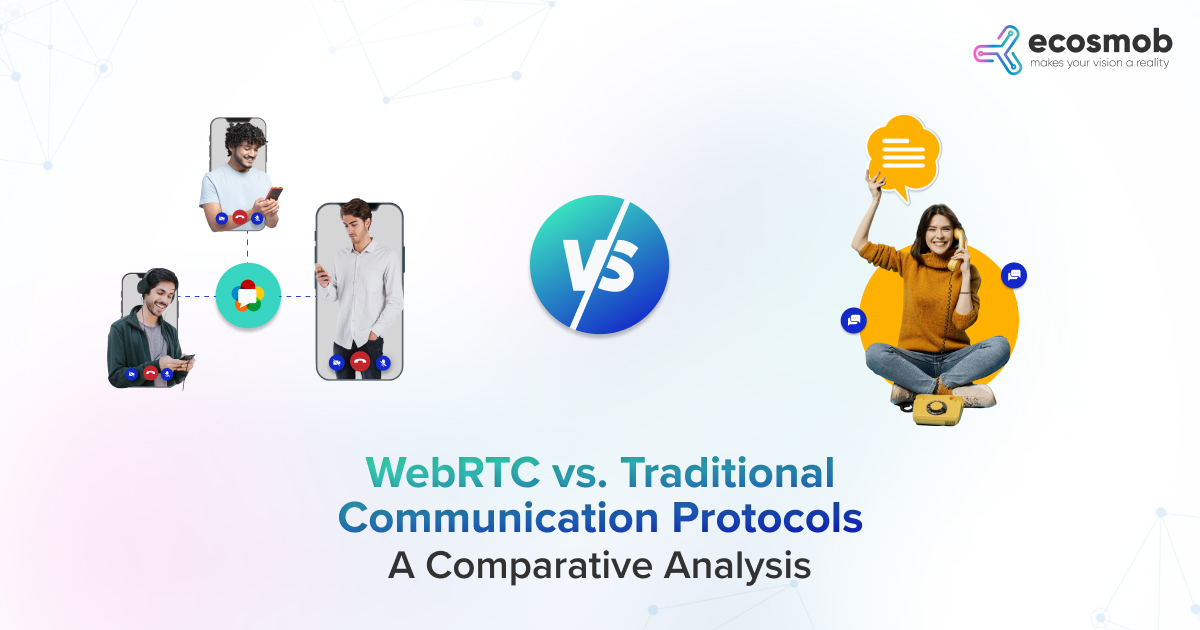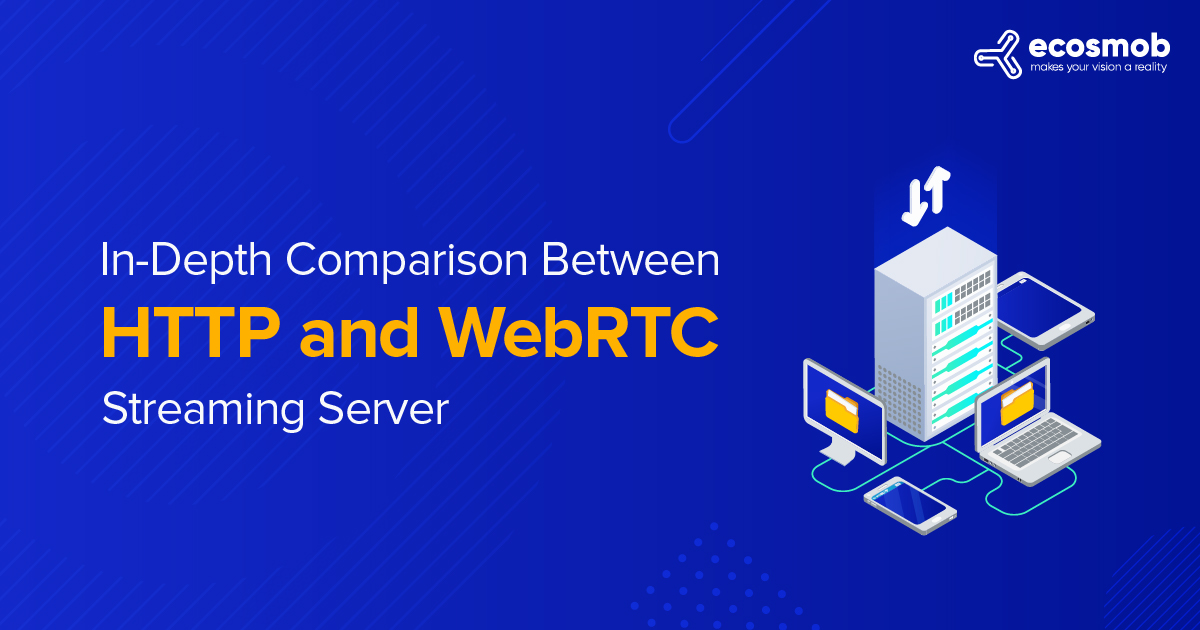QUICK SUMMARY
The Blog summarizes how Software Networks enhance WebRTC performance by improving scalability, security, and network control for seamless communication and how real-world applications leverage this legendary duo.
If you’ve ever used Google Meet, Zoom, or any other video conferencing app, you’ve already experienced WebRTC in action.
WebRTC definition?
WebRTC (Web Real-Time Communication) is a game-changer when it comes to peer-to-peer audio, video, and data sharing over the web – without requiring additional plugins. But while WebRTC software is powerful, it does come with challenges like network congestion, quality fluctuations, and security concerns.
Software-Defined Networking (SDN) – a flexible, intelligent, and programmable approach to network management. SDN can significantly enhance WebRTC scalability service performance, making it more reliable, scalable, and secure.
Let’s dive into how SDN and WebRTC software can work together to revolutionize real-time communication.
Ready to step into the next era of WebRTC?
A Brief Overview of SDN for WebRTC Significance
Before exploring how SDN enhances the capabilities of WebRTC, it is essential to highlight the importance of WebRTC definition. With an open-source WebRTC scalability service technology, programmers can integrate real-time communication capabilities into mobile apps and browsers without an intermediary. This straightforward method has transformed several industries, including telemedicine, online gaming, and contact centers. The need for dependable, scalable, and adaptable WebRTC solution development has never been more significant, given the rise in remote work and virtual communication.
But What is Software Defined Networking (SDN)?
Software Defined Networks (SDN) and Network Functions is a network design, construction, and management methods that divide the network’s forwarding (or muscle) plane from its control. Because of this division, network administrators can control network services by abstracting away lower-level network functions, increasing networks’ flexibility and adaptability.
Consider SDN for WebRTC applications as a traffic director that cleverly directs data packets throughout a network, comprehending the demands and making adjustments as necessary. Based on preprogrammed commands, it can prioritize, de-prioritize, or even block particular kinds of communication.
How does SDN Improve WebRTC Performance?
SDN comes into play here to improve WebRTC performance-based real-time communication. Now, explore SDN’s critical role in WebRTC development services.
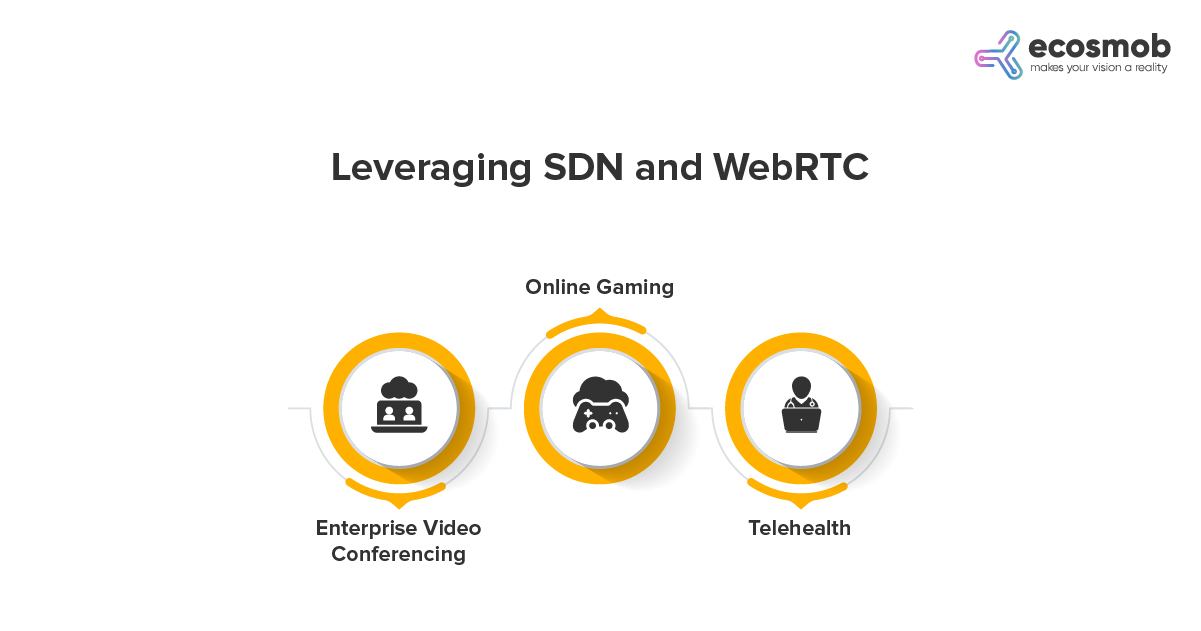 1. Optimized Network Routing
1. Optimized Network Routing
Traditional networks rely on fixed routing, which may not be optimal for real-time communication. SDN, however, uses a centralized controller that:
- Monitors network traffic and adjusts routes dynamically.
- Selects the best path based on current network conditions like latency, jitter, and packet loss.
- Bypasses congested nodes, ensuring WebRTC packets reach their destination quickly.
For example, if a WebRTC call is experiencing lag due to congestion on a certain network path, SDN can reroute traffic through an alternative, less congested path in real time.
2. Lower Latency
WebRTC applications require low-latency communication, especially for video calls, online gaming, and live streaming. SDN reduces latency by:
- Prioritizing WebRTC packets over other types of traffic (e.g., bulk data transfers).
- Implementing real-time path adjustments to avoid slow routes.
- Reducing network hops, ensuring WebRTC packets take the shortest and most efficient route.
For instance, SDN can detect a high-latency path and switch to a lower-latency route without affecting ongoing communication.
3. Bandwidth Management
WebRTC applications require sufficient bandwidth to maintain audio and video quality. SDN ensures intelligent bandwidth allocation by:
- Dynamically assigning bandwidth based on real-time WebRTC session needs.
- Preventing bandwidth hogging by restricting low-priority applications from consuming excessive network resources.
- Ensuring adaptive bitrate streaming, so video quality degrades gracefully instead of causing buffering or freezing.
For example, in a corporate network where multiple video calls are happening, SDN can ensure WebRTC traffic gets adequate bandwidth without being affected by file downloads or other background tasks.
4. Enhanced Quality of Service (QoS)
QoS is critical for real-time communication. SDN improves QoS for WebRTC by:
- Classifying and prioritizing WebRTC packets over less time-sensitive data.
- Implementing traffic shaping to regulate packet flow and avoid jitter.
- Minimizing packet loss by dynamically selecting error-free routes.
For instance, SDN can ensure that WebRTC packets receive the highest priority in a video conferencing system, reducing issues like voice delays and choppy video.
5. Seamless Network Adaptation
WebRTC is used across various network environments – WiFi, LTE, 5G, and corporate LANs – each with different characteristics. SDN allows:
- Real-time adaptation to changing network conditions by modifying routing policies.
- Smart switching between different networks for better performance (e.g., switching between 4G and WiFi).
- Automated network reconfiguration, ensuring smooth handovers when users move between networks.
For example, if a WebRTC user moves from a WiFi network to mobile data, SDN can adjust the connection parameters dynamically to maintain call quality.
6. Load Balancing
SDN helps distribute WebRTC traffic efficiently across multiple network nodes by:
- Distributing WebRTC sessions across multiple servers to prevent overload.
- Redirecting traffic dynamically to maintain performance.
- Ensuring high availability, preventing server crashes from affecting ongoing calls.
For example, an SDN – enabled cloud service can distribute WebRTC sessions among multiple data centers, ensuring consistent performance even during high traffic periods.
7. Better NAT Traversal & Firewall Management
WebRTC requires NAT traversal techniques like STUN, TURN, and ICE to establish peer-to-peer connections. SDN improves this process by:
- Optimizing TURN server selection to reduce relay latency.
- Automating firewall rule adjustments, allowing seamless WebRTC connections.
- Minimizing unnecessary relays, reducing bandwidth usage and improving efficiency.
For example, SDN for WebRTC applications can direct a WebRTC session to the nearest available TURN server instead of routing it through a distant, slower one.
8. Security & DDoS Mitigation
WebRTC is vulnerable to security threats like DDoS attacks, eavesdropping, and session hijacking. SDN enhances WebRTC security by:
- Detecting and blocking malicious traffic in real time.
- Providing encryption-aware routing, ensuring sensitive WebRTC data is protected.
- Implementing dynamic firewall policies, reducing the risk of unauthorized access.
For instance, SDN can identify a DDoS attack targeting a WebRTC server and automatically reroute legitimate traffic to an unaffected server while blocking the attack.
How Real-World Applications are Leveraging SDN and WebRTC?
To further appreciate the advantages of merging SDN and WebRTC, let’s examine a few examples of how SDN integration with WebRTC enables seamless, high-quality communication experiences across various sectors.
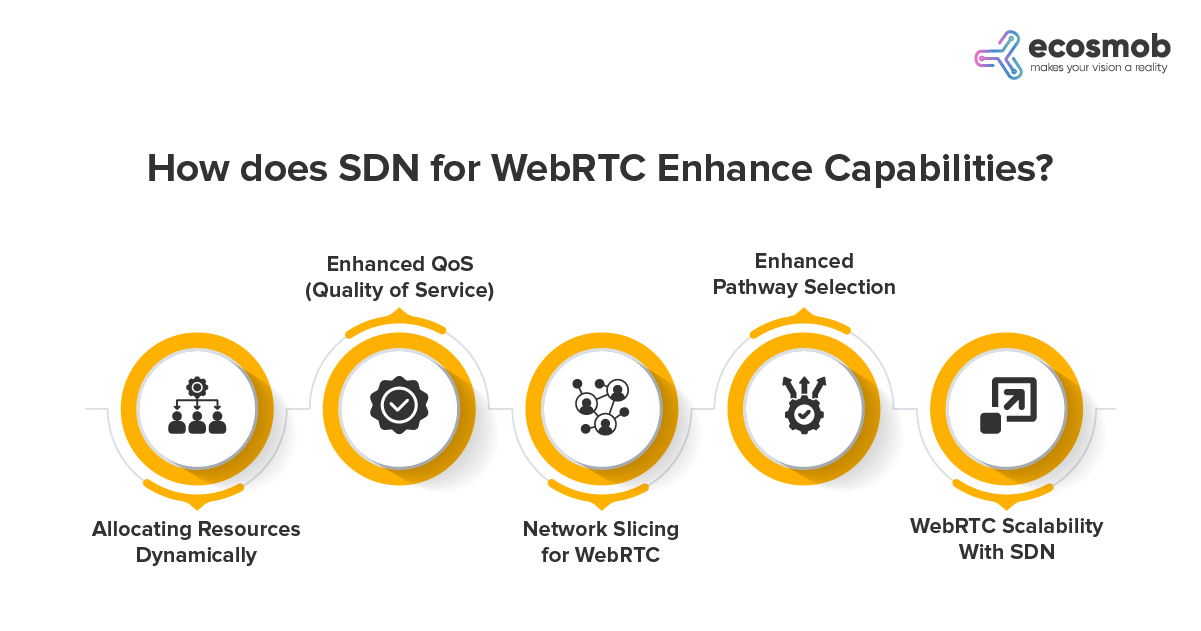 1. Cloud-Based Video Conferencing (Zoom, Google Meet, Microsoft Teams, Cisco Webex)
1. Cloud-Based Video Conferencing (Zoom, Google Meet, Microsoft Teams, Cisco Webex)
Modern video conferencing platforms rely on SDN integration with WebRTC to optimize network paths dynamically. This improves webrtc performance by reducing latency and jitter.
SDN helps improve WebRTC performance by allocating bandwidth intelligently and balancing loads across servers. SDN-enhanced WebRTC solutions in Cisco Webex and Zoom ensure a stable experience even under peak traffic.
WebRTC optimization further enhances call stability, making real-time communication seamless. These methods represent key SDN applications in WebRTC, ensuring smooth video meetings globally.
2. Telemedicine & Remote Healthcare (Teladoc, Amwell, Practo, Babylon Health)
In telemedicine, SDN integration with WebRTC ensures low-latency video consultations. Prioritizing medical video streams significantly improves webrtc performance even in unstable networks.
SDN-driven routing helps improve WebRTC performance by avoiding congestion and adapting to network changes. SDN-enhanced WebRTC solutions ensure that remote consultations remain uninterrupted.
With WebRTC optimization, patient data transmission stays secure and reliable. These are critical SDN applications in WebRTC, enhancing telehealth accessibility.
3. Online Gaming & Game Streaming (Google Stadia, NVIDIA GeForce Now, Xbox Cloud Gaming)
For gaming, SDN integration with Webrtc reduces input lag by optimizing real-time data transmission. This leads to better WebRTC performance, especially in fast-paced multiplayer games.
Dynamic bandwidth allocation helps improve WebRTC performance, preventing latency spikes. SDN-enhanced WebRTC solutions like those in Google Stadia ensure smooth, low-latency gameplay.
WebRTC optimization further fine-tunes data flow, preventing disruptions. These techniques highlight key SDN applications in WebRTC for next-gen cloud gaming.
4. Smart Contact Centers & Customer Support (Amazon Connect, Genesys, Twilio, Five9)
Contact centers use SDN integration with WebRTC to route customer calls efficiently. This enhances WebRTC performance by reducing delays in voice and video streams.
Dynamic load balancing helps improve WebRTC performance by prioritizing critical traffic. SDN-enhanced WebRTC solutions ensure high-quality calls even during peak hours.
Continuous WebRTC optimization maintains call clarity and reliability. These SDN applications in WebRTC are vital for customer service industries.
5. Remote Work & Virtual Collaboration (Slack, Discord, Miro, Gather.Town)
Remote work platforms benefit from SDN integration with Webrtc for stable video calls. This ensures consistent WebRTC performance across different networks.
By adapting to bandwidth fluctuations, SDN helps improve WebRTC performance during meetings. SDN-enhanced WebRTC solutions also prevent lag and connection drops.
With WebRTC optimization, users experience seamless transitions between devices and networks. These SDN applications in WebRTC are essential for efficient remote collaboration.
6. Financial Services & Virtual Trading Desks (Bloomberg, E*TRADE, Robinhood, Interactive Brokers)
Financial firms rely on SDN integration with Webrtc for real-time trading communications. This enhances Webrtc performance by ensuring ultra-low latency data exchange.
Network prioritization helps improve WebRTC performance, making financial decisions more responsive. SDN-enhanced WebRTC solutions guarantee reliable connections during high-stakes transactions.
Ongoing WebRTC optimization minimizes packet loss for accurate financial data transmission. These SDN applications in WebRTC help maintain secure and stable trading operations.
7. Smart Cities & IoT-Based Real-Time Monitoring
In smart cities, SDN integration with Webrtc optimizes traffic monitoring and surveillance feeds. This improves WebRTC performance by ensuring smooth video streaming.
Adaptive routing helps improve WebRTC performance, keeping emergency communication stable. SDN-enhanced WebRTC solutions also enhance security for public safety systems.
Through WebRTC optimization, real-time data from IoT devices is processed efficiently. These SDN applications in WebRTC support the infrastructure of modern smart cities.
Future Proofing SDN and WebRTC – The Legendary Duo
The combination of SDN with WebRTC portends well for digital communication in the future. The demand for real-time communication will rise in tandem with the increasing interconnectedness of our world – WebRTC positions to spearhead this transformation thanks to its browser-based technology.
The collaboration between WebRTC and SDN solutions gives optimism for the advancement of digital communication in the future. The demand for secure, reliable, high-caliber, real-time communication solutions will only grow as the globe grows more interconnected. The peer-to-peer communication capabilities of WebRTC and SDN’s dynamic, adaptable nature can ultimately change how we think about digital communications.
Bringing it all together!
The SDN integration with the WebRTC paradigm is proving essential for advancing WebRTC performance. By leveraging techniques to improve WebRTC performance, industries benefit from robust, real-time communication channels. With Ecosmob SDN-enhanced WebRTC solutions in place, ongoing WebRTC optimization is achievable, ensuring that quality and reliability remain high.
And What’s next?
- As 5G adoption grows, SDN will further optimize WebRTC experiences.
- AI-driven SDN will predict and auto-adjust network paths for even better performance.
- Edge computing + SDN + WebRTC will enable ultra-low-latency applications like autonomous vehicles and AR/VR streaming.





